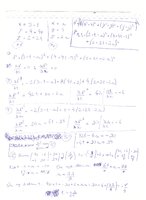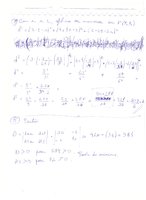Here is my work, I think its done, although, my professor sent us a list without answers, as usual haha.
It gives 2 lines: ?⃗1 = 〈3 − ?; 4 + 4?; 1 + 2?〉 and ?⃗2 = 〈?; 3; 2?〉.
First I determined that the second line I'm using the parameter (s) instead of t.
After that, I wrote my distance as d=sqr (3-t-s)²+(4+4t-3)²+(2+2t-2s)²
I changed to d², cause it will still be the smaller distance.
Ok, 2n I did the partials for d/dt=0 and d/ds=0
3rd n 4th are the answers for dt, dtt, dts, ds, dss, dst.
5th I have done the system, used gauss. I've checked it all on symbolab.
Got t and s. t=-1/24 and s=11/8.
Applied s and t on d².
d²= [(3-t-s)²+(4+4t-3)²+(2+2t-2s)²]
d²= [(3-(-1/24)-(11/8))²+(4+4(-1/24)-3)²+(2+2(-1/24)-2(11/8))²
Got, 109/6 u.d.
Tested by D=| dss dst | and gave me 420-36= 384. So I have that D>0 and Dtt >0, that should be exactly the point of the smaller distance at relative minimum.
| dts dtt |
Does anyone see any flaws? Thanks.
(some notes in my language, nothing important, just saying what I'm doing so I can study the steps, just like I did here in english)
It gives 2 lines: ?⃗1 = 〈3 − ?; 4 + 4?; 1 + 2?〉 and ?⃗2 = 〈?; 3; 2?〉.
First I determined that the second line I'm using the parameter (s) instead of t.
After that, I wrote my distance as d=sqr (3-t-s)²+(4+4t-3)²+(2+2t-2s)²
I changed to d², cause it will still be the smaller distance.
Ok, 2n I did the partials for d/dt=0 and d/ds=0
3rd n 4th are the answers for dt, dtt, dts, ds, dss, dst.
5th I have done the system, used gauss. I've checked it all on symbolab.
Got t and s. t=-1/24 and s=11/8.
Applied s and t on d².
d²= [(3-t-s)²+(4+4t-3)²+(2+2t-2s)²]
d²= [(3-(-1/24)-(11/8))²+(4+4(-1/24)-3)²+(2+2(-1/24)-2(11/8))²
Got, 109/6 u.d.
Tested by D=| dss dst | and gave me 420-36= 384. So I have that D>0 and Dtt >0, that should be exactly the point of the smaller distance at relative minimum.
| dts dtt |
Does anyone see any flaws? Thanks.
(some notes in my language, nothing important, just saying what I'm doing so I can study the steps, just like I did here in english)


